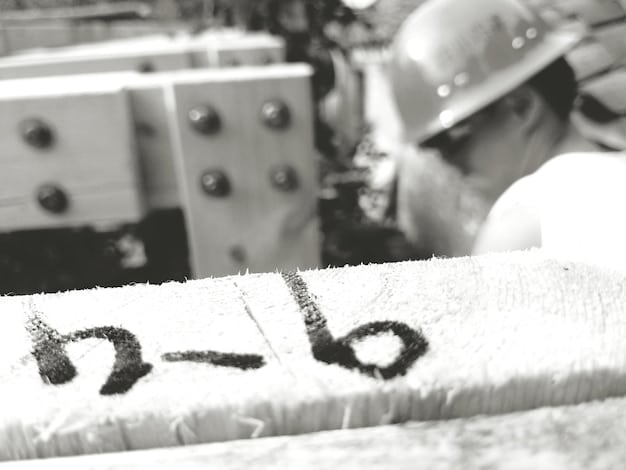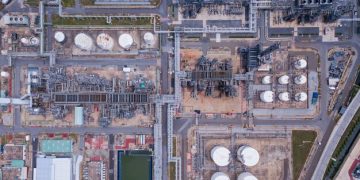US Companies Lead the Way with Carbon-Negative Concrete

US companies are pioneering carbon-negative concrete, transforming the construction industry by reducing and even reversing carbon emissions, contributing to a more sustainable future.
The construction industry is a significant contributor to global carbon emissions, but innovative **US Companies Pioneer Carbon-Negative Concrete: Building a Greener Future** with revolutionary approaches. These companies are developing and implementing technologies that not only reduce the carbon footprint of concrete but also actively remove carbon dioxide from the atmosphere, offering a pathway to a greener future.
The Urgent Need for Sustainable Concrete
The urgency for adopting sustainable practices in construction cannot be overstated. Traditional concrete production is a major source of carbon emissions, contributing significantly to climate change. Recognizing this, US companies are stepping up to address the challenge by developing and deploying carbon-negative concrete solutions.
The Environmental Impact of Traditional Concrete
Traditional concrete production involves the heating of limestone to create cement, a process that releases large amounts of carbon dioxide. This, combined with the energy-intensive processes involved in transporting and mixing concrete, makes it a significant contributor to greenhouse gas emissions.
The Rise of Sustainable Building Materials
As awareness of the environmental impact of traditional concrete grows, so does the demand for sustainable alternatives. Carbon-negative concrete represents a promising solution, offering a way to build structures while actively reducing atmospheric carbon dioxide.
- Reduces carbon emissions associated with construction.
- Contributes to carbon sequestration, removing CO2 from the atmosphere.
- Offers a durable and reliable alternative to traditional concrete.
The development and adoption of carbon-negative concrete are crucial steps towards creating a more sustainable and environmentally responsible construction industry. By embracing these innovative solutions, we can mitigate the impact of construction on the environment and work towards a greener future.

How Carbon-Negative Concrete Works
The magic behind carbon-negative concrete lies in its unique composition and manufacturing processes. Unlike traditional concrete, which releases carbon dioxide during production, carbon-negative concrete actively absorbs CO2 from the environment.
Mineralization of Carbon Dioxide
One of the key processes involved in creating carbon-negative concrete is the mineralization of carbon dioxide. This involves capturing CO2 from industrial sources and reacting it with calcium or magnesium-rich materials to form stable carbonates, effectively locking away the carbon dioxide.
Alternative Binders and Aggregates
In addition to mineralization, carbon-negative concrete often utilizes alternative binders and aggregates that have a lower carbon footprint than traditional cement. These materials can include recycled aggregates, supplementary cementitious materials (SCMs), and even bio-based materials.
The utilization of these innovative processes and materials allows carbon-negative concrete to not only reduce emissions but also actively sequester carbon dioxide, making it a game-changer in the quest for sustainable construction.
US Companies Leading the Charge
Several US companies are at the forefront of developing and commercializing carbon-negative concrete technologies. These pioneers are pushing the boundaries of innovation, transforming the construction industry and paving the way for a more sustainable future.
CarbonCure Technologies
CarbonCure Technologies is one of the leading companies in the carbon-negative concrete space. They have developed a technology that injects captured carbon dioxide into fresh concrete, where it mineralizes and becomes permanently embedded, increasing the concrete’s strength and reducing its carbon footprint.
Blue Planet Systems
Blue Planet Systems takes a different approach, capturing carbon dioxide from power plants and using it to create synthetic limestone aggregate. This aggregate can then be used to produce carbon-negative concrete, effectively turning a waste product into a valuable building material.

These companies are not only developing innovative technologies but also working to scale up production and drive down costs, making carbon-negative concrete a viable and competitive alternative to traditional concrete. Their efforts are essential for accelerating the adoption of sustainable construction practices.
Benefits of Using Carbon-Negative Concrete
The benefits of using carbon-negative concrete extend far beyond simply reducing carbon emissions. This innovative material offers a range of advantages that make it an attractive option for builders, developers, and policymakers alike.
Environmental Advantages
The most obvious benefit of carbon-negative concrete is its positive impact on the environment. By reducing and even reversing carbon emissions, it helps to mitigate climate change and create a more sustainable future. It is also helps in reducing the reliance on traditional carbon-heavy materials.
Economic Advantages
While carbon-negative concrete may currently have a higher upfront cost than traditional concrete in some cases, it offers long-term economic advantages. These include reduced carbon taxes, lower energy costs, and the potential for carbon credits.
Performance Advantages
In many cases, carbon-negative concrete offers performance advantages over traditional concrete. For example, the mineralization of carbon dioxide can increase the concrete’s strength and durability, leading to longer-lasting structures.
- Contributes to LEED certification and other green building standards.
- Enhances a company’s sustainability profile and reputation.
- Reduces the risk of future carbon regulations and taxes.
The combination of environmental, economic, and performance advantages makes carbon-negative concrete a compelling choice for a wide range of construction projects, positioning it as a key material in the transition to a more sustainable built environment.
Challenges and Opportunities
While carbon-negative concrete holds tremendous promise, there are still challenges to overcome before it can become a mainstream building material. However, these challenges also present significant opportunities for innovation and growth.
Cost Considerations
One of the main challenges is the cost of producing carbon-negative concrete. The technologies involved in capturing and mineralizing carbon dioxide can be expensive, which can make carbon-negative concrete less competitive than traditional concrete in some markets.
Scaling Up Production
Another challenge is scaling up production to meet the growing demand for sustainable building materials. Many carbon-negative concrete technologies are still in the early stages of commercialization, and significant investments are needed to expand production capacity.
Policy and Regulatory Support
Policy and regulatory support are also crucial for the widespread adoption of carbon-negative concrete. Government incentives, building codes, and procurement policies can all play a role in creating a level playing field and encouraging the use of sustainable materials.
By addressing these challenges and capitalizing on the opportunities, we can unlock the full potential of carbon-negative concrete and accelerate the transition to a more sustainable construction industry. This includes investment in R&D for better technologies and exploring the potential for carbon credit programs for companies investing and deploying these new technologies.
The Future of Construction with Carbon-Negative Concrete
The future of construction is undoubtedly green, and carbon-negative concrete is poised to play a central role in shaping that future. As technologies mature, costs decline, and awareness grows, carbon-negative concrete is set to become a mainstream building material, transforming the way we build our cities and infrastructure.
Wider Adoption and Innovation
The wider adoption of carbon-negative concrete will spur further innovation, leading to even more efficient and cost-effective technologies. This will, in turn, drive down costs and make carbon-negative concrete even more competitive.
Integration with Smart Technologies
Carbon-negative concrete can also be integrated with smart technologies, such as sensors and data analytics, to create buildings and infrastructure that are not only sustainable but also more efficient and resilient. These integrated approaches will be critical in addressing the complex challenges of the 21st century.
- Greater collaboration between industry, government, and academia.
- Increased investment in research and development.
- A shift towards a circular economy approach to construction.
The transition to carbon-negative concrete represents a fundamental shift in the construction industry, one that will require collaboration, innovation, and a commitment to sustainability. By embracing this shift, we can build a greener, more resilient future for generations to come.
| Key Point | Brief Description |
|---|---|
| 🌱 Carbon Sequestration | Actively removes CO2 from the atmosphere during concrete production. |
| 💰 Economic Benefits | Potential for carbon credits, reduced carbon taxes, and lower energy costs. |
| 🏢 Improved Performance | Enhanced strength and durability compared to traditional concrete. |
| 🌎 Sustainability | Supports green building standards and enhances corporate sustainability profiles. |
Frequently Asked Questions
Carbon-negative concrete actively absorbs more carbon dioxide from the atmosphere than is emitted during its production. This is achieved through mineralization and alternative binders.
It reduces the overall carbon footprint of construction projects by sequestering CO2. It also lessens the reliance on traditional, carbon-intensive concrete production methods, and the need to extract raw materials.
Yes, in many cases, carbon-negative concrete offers enhanced strength and durability. The CO2 mineralization process can improve the concrete’s overall structural integrity and resistance to degradation.
Companies like CarbonCure Technologies and Blue Planet Systems are at the forefront. They are pioneering innovative techniques for capturing and utilizing CO2 in concrete production and are revolutionizing this space.
The initial costs and scaling up production are the main hurdles. Policy and regulatory support also need to improve to create incentives to switch to sustainable material and help the economics.
Conclusion
The pioneering efforts of US companies in developing and implementing carbon-negative concrete represent a significant step towards a more sustainable future. By embracing these innovations, the construction industry can mitigate its environmental impact and contribute to a greener, more resilient world.





